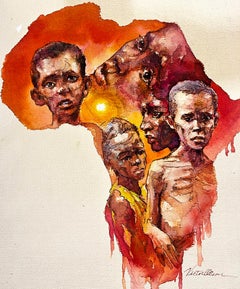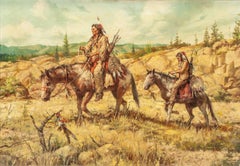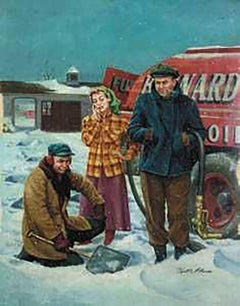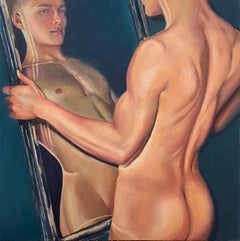Victor Olson Art
to
3
3
2
1
1
1
African Children Suffer Famine and Despair in Hot Colors - Africa is Bleeding
By Victor Olson
Located in Miami, FL
An intense and powerful study of five undernourished and perhaps starving African children partly superimposed and partly integrated into the silhouette of the African continent...
Category
1970s Realist Victor Olson Art
Materials
Watercolor, Graphite
Western Scene
By Victor Olson
Located in Fort Washington, PA
Medium: Oil on Canvas
Dimensions: 20.00" x 29.00"
Signature: Signed Lower Right
Category
Late 20th Century Victor Olson Art
Materials
Canvas, Oil
Fuel Oil Delivery
By Victor Olson
Located in Fort Washington, PA
Medium: Oil on Board
Signature: Signed Lower Right
Category
1940s Victor Olson Art
Materials
Oil, Board
Related Items
Watch me! -21st Century Oil Painting of a Nude Boy watching you in his Mirror
By David van der Linden
Located in Nuenen, Noord Brabant
This painting is made by Dutch artist/painter David van der Linden.
Painted with oilpaint on canvas.
David van der Linden studied at the Academ...
Category
2010s Contemporary Victor Olson Art
Materials
Canvas, Oil
$4,128
H 39.38 in W 39.38 in D 3.94 in
Untitled (Man Reclining on Tile Floor)
By Mark Beard
Located in New York, NY
Graphite and conté crayon on paper
Signed and dated, l.r.
This artwork is offered by ClampArt, located in New York City.
Mark Beard, born in 1956 in Salt Lake City, now lives in Ne...
Category
1970s Realist Victor Olson Art
Materials
Paper, Graphite, Conté
"Sunny Day" Edward Dufner, American, Impressionist Clouds, Light Blue Sky
By Edward Dufner
Located in New York, NY
Edward Dufner
Sunny Day
Signed lower right
Oil on board
8 x 10 inches
With a long-time career as an art teacher and painter of both 'light' and 'dark', Edward Dufner was one of the...
Category
1910s American Impressionist Victor Olson Art
Materials
Oil, Board
A sitter - Realistic oil painting, Female nude, Warm tones, Young Polish artist
Located in Warsaw, PL
AGNIESZKA STAAK-JANCZARSKA (born in 1994)
A graduate of the State Secondary School of Art of Józef Kluza in Krakow. In 2020, she graduated from the Academy of Fine Arts in Krakow in ...
Category
2010s Naturalistic Victor Olson Art
Materials
Oil, Cardboard
17th Century Memento Mori Vanitas Skull Old Master Oil Ex-Christie’s
Located in Yardley, PA
This wonderful 17th-century French School vanitas painting is a meditation on mortality and the transience of earthly pleasures. The composition centers on a finely rendered human sk...
Category
17th Century Old Masters Victor Olson Art
Materials
Canvas, Oil
$6,500
H 21.88 in W 25.25 in D 1.5 in
“Quebec City, 1853” Panoramic Landscape View, Cityscape, Canada Signed Oil
By Edmund C. Coates
Located in Yardley, PA
“Quebec City, 1853” by Edmund C. Coates (American, 1816-1871).
A luminous 19th-century view of Quebec City by the American painter Edmund C. Coates, known for his detailed Hudson Ri...
Category
1850s Hudson River School Victor Olson Art
Materials
Canvas, Oil
$4,500
H 31.5 in W 39 in D 2.5 in
Untitled. Realistic figurative oil painting, Nude, Young Polish artist
Located in Warsaw, PL
Contemporary figurative nude oil on cardboard painting by Polish artist Agnieszka Staak-Janczarska. Painting depicts a woman sitting on a floor with her head resting on her knee. Art...
Category
2010s Naturalistic Victor Olson Art
Materials
Oil, Cardboard
Tossa de mar spanish seascape original oil on cardboard painting mediterranean
By Josep Marfa Guarro
Located in Sitges, Barcelona
Frame size 38x44 cm.
Josep Marfa Guarro (1928-2014)
Josep Marfa Guarro was a Catalan painter specialized in landscape painting.
Among Josep Marfa Guarro's work are numerous waterc...
Category
1980s Impressionist Victor Olson Art
Materials
Oil, Cardboard
A sitting one - Figurative Oil Realistic painting, Young artist, Female nude
Located in Warsaw, PL
AGNIESZKA STAAK-JANCZARSKA (born in 1994)
A graduate of the State Secondary School of Art of Józef Kluza in Krakow. In 2020, she graduated from the Aca...
Category
2010s Naturalistic Victor Olson Art
Materials
Oil, Board
$670 Sale Price
20% Off
H 16.93 in W 12.41 in
Robert Kenneth White "Sanctuary in Feathers" Large Figurative Oil Painting
Located in Miami, FL
ROBERT KENNETH WHITE – "SANCTUARY IN FEATHERS"
⚜ Oil on Canvas ⚜ Hand Signed Lower Right ⚜ Frameless Display
HUMANITY AND HARMONY
“Sanctuary in Feathers” captures a poignant moment ...
Category
2010s Realist Victor Olson Art
Materials
Canvas, Oil
Robert Kenneth WhiteRobert Kenneth White "Sanctuary in Feathers" Large Figurative Oil Painting, 2018
$4,900 Sale Price
30% Off
H 45 in W 38 in D 1 in
Robert White "Modern Mythology" 2021 Oil with Anatomical Realism & Surreal Edge
Located in Miami, FL
ROBERT KENNETH WHITE – "MODERN MYTHOLOGY"
⚜ Oil on canvas ⚜ Hand signed lower right ⚜ Frameless display
SURREALISM MEETS CONTEMPORARY PORTRAITURE
In “Modern Mythology,” Robert Kenne...
Category
2010s Realist Victor Olson Art
Materials
Canvas, Oil
$1,960 Sale Price
30% Off
H 24 in W 20.125 in D 0.75 in
"Charcoal Portrait of a Young Girl" (2023) By Bunyod Suvonov, Original Drawing
Located in Denver, CO
"I Saw You in My Dreams" (2023) by Bunyod Suvonov is original handmade drawing made with charcoal and graphite on toned paper. This piece depicts a portrait of a woman with long blac...
Category
20th Century Realist Victor Olson Art
Materials
Paper, Charcoal, Graphite
$2,400
H 17 in W 17 in D 1 in
Victor Olson art for sale on 1stDibs.
Find a wide variety of authentic Victor Olson art available for sale on 1stDibs. You can also browse by medium to find art by Victor Olson in paint, oil paint, board and more. Not every interior allows for large Victor Olson art, so small editions measuring 15 inches across are available. Customers who are interested in this artist might also find the work of John McCormick, Arnold Blanch, and Adrienne Stein. Victor Olson art prices can differ depending upon medium, time period and other attributes. On 1stDibs, the price for these items starts at $5,900 and tops out at $6,900, while the average work can sell for $6,000.




